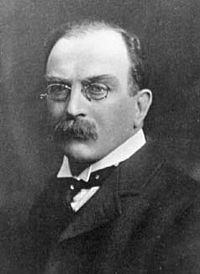Joseph Larmor – Wikipédia, a enciclopédia livre
| Joseph Larmor | |
|---|---|
| circa 1920 | |
| Nascimento | 11 de julho de 1857 Magheragall |
| Morte | 19 de maio de 1942 (84 anos) Holywood |
| Nacionalidade | |
| Alma mater | Queen's University of Belfast, Universidade de Cambridge |
| Prêmios | Prêmio Smith (1880), Prêmio Adams (1899), Professor lucasiano (1903), Medalha De Morgan (1914), Medalha Real (1915), Prêmio Poncelet (1919), Medalha Copley (1921) |
| Orientado(a)(s) | Kwan-ichi Terazawa |
| Instituições | St John's College (Cambridge), Universidade Nacional da Irlanda, Galway |
| Campo(s) | Física, matemática |
Joseph Larmor (Magheragall, 11 de julho de 1857 — Holywood, 19 de maio de 1942) foi um físico e matemático irlandês.
De 1903 a 1932 foi professor lucasiano do Trinity College da Universidade de Cambridge. Seu antecessor foi George Gabriel Stokes e seu sucessor Paul Dirac.
Obra[editar | editar código-fonte]
Larmor foi o primeiro a publicar a transformação de Lorentz, em 1897,[1] dois anos antes de Hendrik Antoon Lorentz e oito anos antes de Albert Einstein.
Publicações[editar | editar código-fonte]
- 1887, „On the direct applications of first principles in the theory of partial differential equations,“ Proceedings of the Royal Society.
- 1891, „On the theory of electrodynamics,“ Proceedings of the Royal Society.
- 1892, „On the theory of electrodynamics, as affected by the nature of the mechanical stresses in excited dielectrics,“ Proceedings of the Royal Society.
- 1893-97, „Dynamical Theory of the Electric and Luminiferous Medium,“ Proceedings of the Royal Society; Philosophical Transactions of the Royal Society. Reihe aus 3 Artikeln mit Larmors physikalischer Theorie des Alls.
- 1894, „Least action as the fundamental formulation in dynamics and physics,“ Proceedings of the London Mathematical Society.
- 1896, „The influence of a magnetic field on radiation frequency,“ Proceedings of the Royal Society.
- 1896, „On the absolute minimum of optical deviation by a prism,“ Proceedings of the Cambridge Philosophical Society.
- J. Larmor (1897). On a Dynamical Theory of the Electric and Luminiferous Medium, Part 3, Relations with material media. Phil. Trans. Roy. Soc. 190. [S.l.: s.n.] p. 205-300. Enthält die Lorentztransformation.
- 1898, „Note on the complete scheme of electrodymnamic equations of a moving material medium, and electrostriction,“ Proceedings of the Royal Society.
- 1898, „On the origin of magneto-optic rotation,“ Proceedings of the Cambridge Philosophical Society.
- J. Larmor (1900). Aether and Matter. [S.l.]: Cambridge University Press. Enthält ebenfalls die Lorentztransformation.
- 1903, „On the electrodymanic and thermal relations of energy of magnetisation,“ Proceedings of the Royal Society.
- 1907, „Aether“ in Encyclopædia Britannica, 11th ed. London.
- 1908, „William Thomson, Baron Kelvin of Largs. 1824-1907“ (Obituary). Proceedings of the Royal Society.
- 1924, „On Editing Newton,“ Nature.
- 1927, „Newtonion time essential to astronomy,“ Nature.
- 1929, „Mathematical and Physical Papers. Cambridge Univ. Press.
Ver também[editar | editar código-fonte]
Referências
Ligações externas[editar | editar código-fonte]
- John J. O’Connor, Edmund F. Robertson: Joseph Larmor. In: MacTutor History of Mathematics archive.
- Joseph Larmor (em inglês) no Mathematics Genealogy Project
- "A very short biography of Joseph Larmor"
- "Ether and field theories in the late 19th century" At VictorianWeb: History of science in the Victorian era
- "Papers of Sir Joseph Larmor". Janus, University of Cambridge.
| Precedido por George Gabriel Stokes | Professor lucasiano 1903 – 1932 | Sucedido por Paul Dirac |
| Precedido por Horace Lamb | Medalha De Morgan 1914 | Sucedido por William Henry Young |
| Precedido por Ernest William Brown e William Johnson Sollas | Medalha Real 1915 com William Halse Rivers Rivers | Sucedido por Hector Munro Macdonald e John Scott Haldane |
| Precedido por Horace Brown | Medalha Copley 1921 | Sucedido por Ernest Rutherford |


 French
French Deutsch
Deutsch